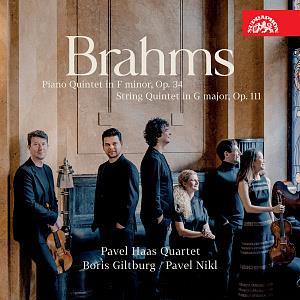A game of two halves as the Pavel Haas joins forces in Brahms

The Strad Issue: June 2022
Description: A game of two halves as the Pavel Haas joins forces in Brahms
Musicians: Pavel Haas Quartet, Pavel Nikl (viola) Boris Giltburg (piano)
Works: Brahms: Piano Quintet op.34; String Quintet no.2 op.111
Catalogue number: SUPRAPHON SU 4306-2
These two quintets come from either end of Brahms’s career and display contrasting facets of his musical personality. For the late G major String Quintet (1890), Brahms adds a second viola to the mix, enhancing the group’s middle range. The Pavel Haas Quartet is joined by its former violist, Pavel Nikl, whose walnutty timbre acts as a piquant foil to the rich, chocolatey tone of Luosha Fang. This is a group whose sound is built from the bottom up, however, and it is the cello of Peter Jarůšek that forms the solid basis of this interpretation, whether it be the joyously sprawling theme of the opening movement or the pregnant pizzicatos that drive the Adagio. The players revel in the work’s changing moods with full-toned freedom in the sonorous surroundings of Prague’s Domovina Studio.
Where the String Quintet is radiant and vivacious, the Piano Quintet of almost 30 years earlier is stormy and impetuous. Here it’s the piano that provides the engine of the work, and this is where the major problem lies. Boris Giltburg seems unwilling to meet this hyper-Romantic music on its own terms, opting instead for a verbatim re-creation of the piano part, leeched of its character and momentum. His striving for accuracy comes at the expense of impetus, a doggedness in his figuration particularly damagingly in the opening movement. The cantilena of the Andante is sung eloquently and, in the Scherzo and towards the end of the finale, the performance begins to ignite – but by then it’s too late. The Artemis Quartet and Leif Ove Andsnes (Virgin/Erato) are altogether more compelling. But buy this for the PHQ’s affectionate reading of G major Quintet.
DAVID THREASHER



































No comments yet